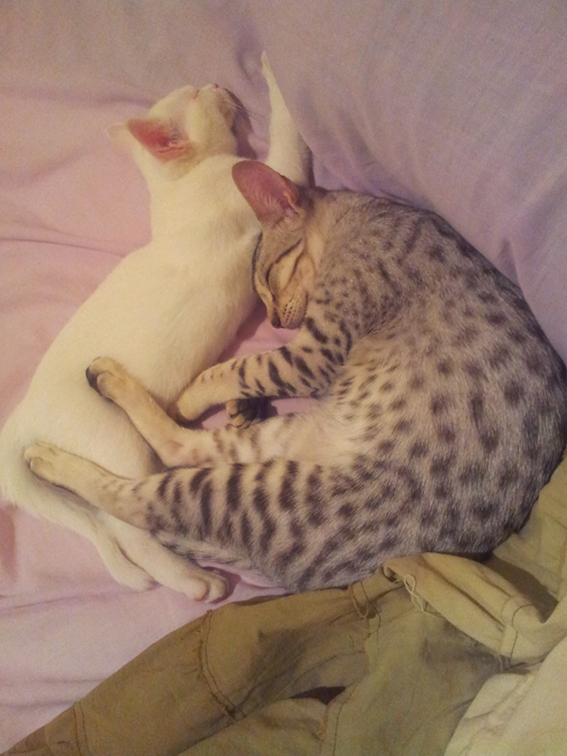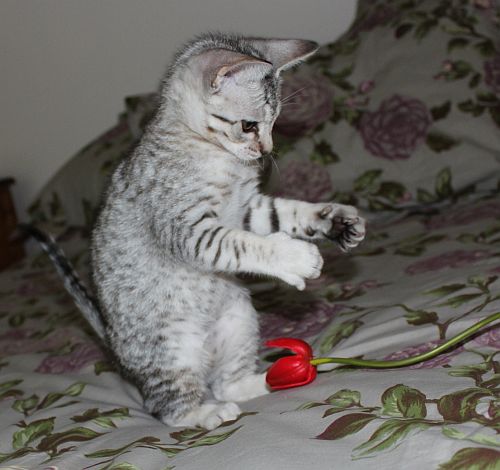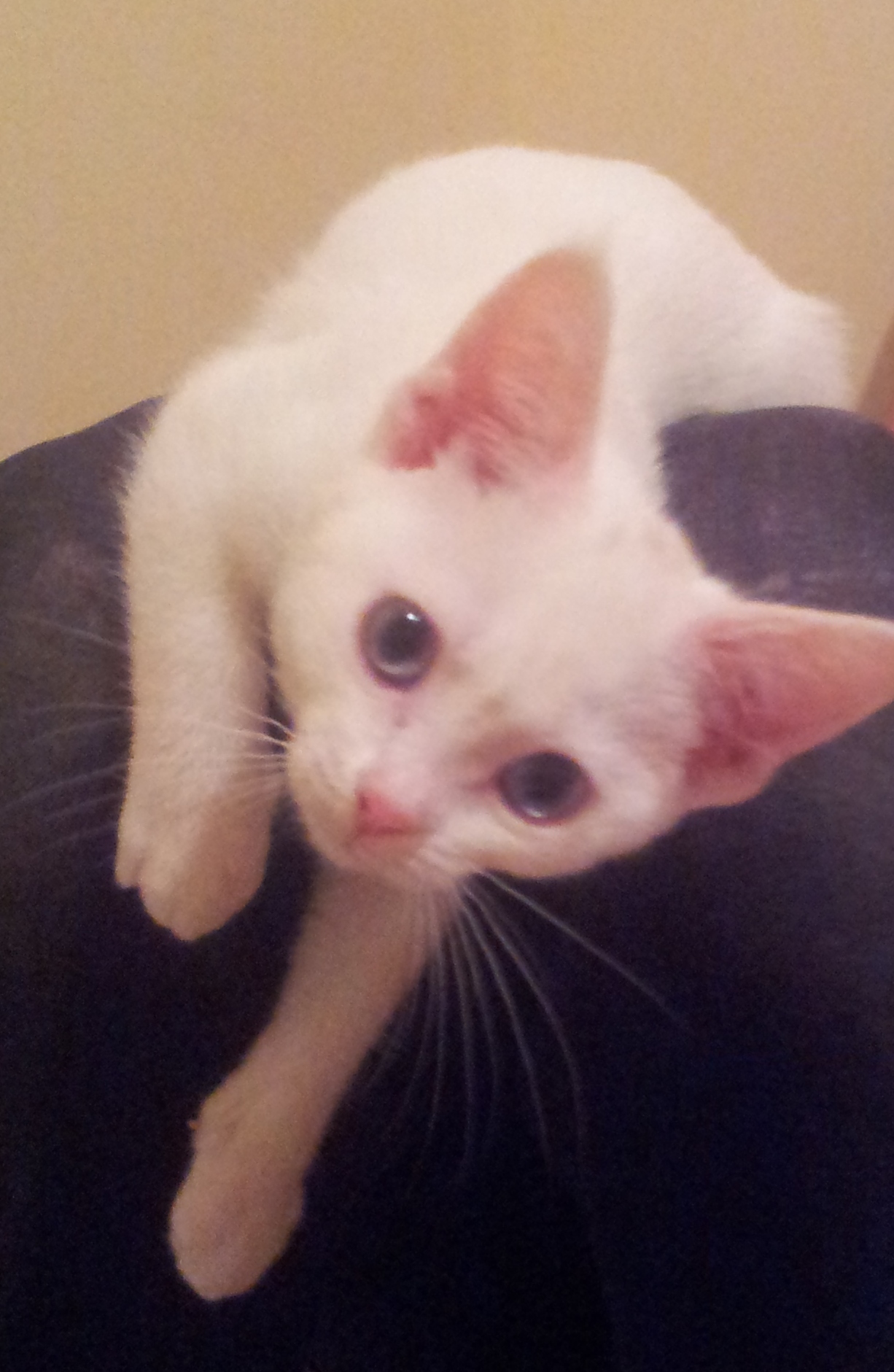Cats are often – almost always, in fact – regarded by gardeners and permaculture practitioners as nuisances at best. Words like vicious and useless are applied, cats are describes as being inclined to torture and kill small animals and birds if they can get access to them. I don’t understand where this animosity comes from. Cats are no more nasty or cruel than any other predator. Feral dogs will hunt animals, run them down and worry them to death. Chickens will peck a smaller bird, like a pigeon, or a small animal to death and then eat it if it gets into their run and can’t get out. But in dogs and chickens we overlook these bloodthirsty tendencies. Why do so many people hate cats?
 I like cats. I think I’ve always liked cats (and dogs, and bunnies, and any other furry or feathered critter which would stand still and tolerate me touching it – I was that kid). I’ve wanted to adopt a kitty since I was 6 years old, although I haven’t actually managed to include a cat in my life until recently due to circumstance. In December I adopted two kittens – one a purebred ocicat, from a lovely breeder in Victoria, and one a devon rex cross who was left at the local vet with her sisters (the remaining sisters have since also found homes and people to love them). My kitties are both highly domesticated – they seek out human company, and purr when they are petted or picked up even by people they don’t know. They sleep curled up against my side, sharing their warmth with me as they would with other cats in the same social cloud, and rub their faces on me to share our scents and reinforce the bond that holds us together as a social group.
I like cats. I think I’ve always liked cats (and dogs, and bunnies, and any other furry or feathered critter which would stand still and tolerate me touching it – I was that kid). I’ve wanted to adopt a kitty since I was 6 years old, although I haven’t actually managed to include a cat in my life until recently due to circumstance. In December I adopted two kittens – one a purebred ocicat, from a lovely breeder in Victoria, and one a devon rex cross who was left at the local vet with her sisters (the remaining sisters have since also found homes and people to love them). My kitties are both highly domesticated – they seek out human company, and purr when they are petted or picked up even by people they don’t know. They sleep curled up against my side, sharing their warmth with me as they would with other cats in the same social cloud, and rub their faces on me to share our scents and reinforce the bond that holds us together as a social group.
Research has shown that the frequency of a domestic cat’s purr helps them heal injuries and broken bones, and may do the same for humans. We’ve known for a long time that a cat purring on your lap decreases stress levels (measurable reductions in blood cortisol levels), but it may also increase bone density, assist with the healing of injuries, and provide a measure of relief for people suffering from chronic pain. Living with a cat that likes you is good for you.
 Cats were originally domesticated, as far as we can tell, for their hunting and pest control powers. Inside the house that means catching and killing bugs like crickets and cockroaches which otherwise tend to come inside after the food scraps and crumbs that humans inevitably create. Outside it usually means keeping rodents away from food storage areas, both bulk human food storage like grain silos or grain bins and also livestock feed. Although my cats will not be allowed outdoors unsupervised, I think I will put a little cat access run so they can come and go from the feed shed (once the house and feed shed are built) to control the rodent population. Cats are very useful for mouse and rat control, and just their presence is a strong disincentive to rodents moving in; Milkwood have tried it, and it seems pretty plausible. I may also set up circuits for them past the chicken run and pigeon coop to see if the presence of and competing-predator-smell of cats might deter foxes – cats aren’t much of a deterrent (foxes can and will kill and eat cats) but maybe a fox would think twice about checking out my livestock if I have guard cats.
Cats were originally domesticated, as far as we can tell, for their hunting and pest control powers. Inside the house that means catching and killing bugs like crickets and cockroaches which otherwise tend to come inside after the food scraps and crumbs that humans inevitably create. Outside it usually means keeping rodents away from food storage areas, both bulk human food storage like grain silos or grain bins and also livestock feed. Although my cats will not be allowed outdoors unsupervised, I think I will put a little cat access run so they can come and go from the feed shed (once the house and feed shed are built) to control the rodent population. Cats are very useful for mouse and rat control, and just their presence is a strong disincentive to rodents moving in; Milkwood have tried it, and it seems pretty plausible. I may also set up circuits for them past the chicken run and pigeon coop to see if the presence of and competing-predator-smell of cats might deter foxes – cats aren’t much of a deterrent (foxes can and will kill and eat cats) but maybe a fox would think twice about checking out my livestock if I have guard cats.
 In permaculture terms, the cat provides companionship, stress relief (and possibly assistance with healing and pain relief), pest control, and manure (which is perfectly compostable, just like any other manure). Cats do also produce fur, and the fur from longhaired cats can be spun, but I think that might be reaching a little for uses for our feline friends. Mostly the fur cats produce doesn’t have any real use that I’ve found or thought of. Cats require food, water, air, a warm safe space to sleep, something to scratch and strop their claws on, a high place or two to perch, a litterbox or designated and regularly cleaned place to defecate, mental stimulation (play, toys, etc.), and companionship *.
In permaculture terms, the cat provides companionship, stress relief (and possibly assistance with healing and pain relief), pest control, and manure (which is perfectly compostable, just like any other manure). Cats do also produce fur, and the fur from longhaired cats can be spun, but I think that might be reaching a little for uses for our feline friends. Mostly the fur cats produce doesn’t have any real use that I’ve found or thought of. Cats require food, water, air, a warm safe space to sleep, something to scratch and strop their claws on, a high place or two to perch, a litterbox or designated and regularly cleaned place to defecate, mental stimulation (play, toys, etc.), and companionship *.
* Yes, domestic cats are social animals. They are not really lone predators, standoffish and aloof – feral cats, away from human intervention, form social groups which engage in joint rearing of kittens, joint protection of shared territory, communal eating, and playing and sleeping together. These are not the behaviours of an unsociable species. Cats don’t have a clear hierarchical social structure like dogs, but they do have a clear social structure with stable relationships between individuals.
I guess my point is, cats not nearly as useless and nasty as people seem to think. They’re useful in some circumstances, just like every plant and animal we work with is. No one has to keep a cat, but there’s nothing wrong with keeping a cat – or dog, chicken, rabbit, goat, alpaca, cow, horse, or any other domesticated animal. Yes, a free roaming cat will kill a few birds – but it’ll be far fewer than humans kill every year, both directly (hello feathery smear on the front of the car, you didn’t move fast enough I guess) and indirectly (via habitat destruction for urbanisation, poisons meant for other ‘pest’ animals, or the removal of the species which birds rely on for food).